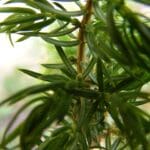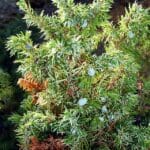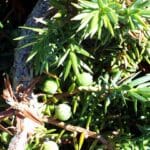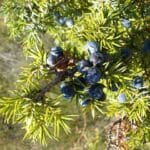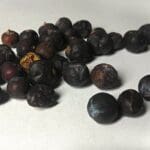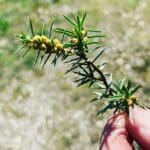Juniper / Summer / Autumn / Winter / Edible
Common Name
Juniper
Botanical Name
Juniperus communis
Scientific Classification
Kingdom – Plantae
Order – Cupressales
Family – Cupressaceae
Physical Characteristics of Juniper
A small evergreen tree or shrub varying from tall, columnar trees, 20-40 metres tall or low-spreading shrubs with long trailing branches.
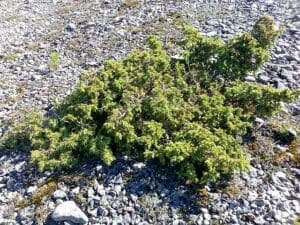
Stem
Upright or prostrate. The bark is reddish-brown, peeling in papery sheets.
The twigs are slender with ridges on the three angles, pale brown.
Leaves
The leaves are short spiky needles up to 1.5cm long; green with a single broad, whitish band the length of the upper surface. Leaves form in successive whorls of three, jointed at the base and sharply pointed at the tip. The needles are hard and sharp, making foliage prickly to handle.
Other Juniper species (eg. J. Chinensis, J. Virginia) have two types of leaves; seedlings and some twigs of older trees have needle-like leaves 5-25mm long, as above; on mature plants the leaves are overlapping like tiny scales measuring 2-4mm.
Flowers/Fruit
Junipers are gymnosperms, meaning “Naked seed”, so they don’t have flowers or fruit; instead they have seed cones. The male cones are solitary, yellow, green or brown and produced in the leaf axils; they shed pollen in March.
Female cones are very distinctive with their fleshy, fruit-like, coalescing scales which fuse together to form a berry-like structure (galbulus). Seed maturation takes place over two years. Small green cones form in the first year and become dark blue in their second year; these are called Juniper berries, although they are not strictly berries.
Habitat
One of the two conifers which are native to England, Wales and Ireland, the other being Yew. (In Scotland Juniper, Yew and Scots Pine are the only native conifers). Juniper is locally common in the South and South-east of England, the Lake District and the far North. In Ireland it is common on the West and North-west coasts.
Chalk downs, heaths, moors and pine and birch woods. Often dominant in scrub on chalk, limestone and slate.
Known Hazards
Oil from the related Juniperus sabina is said to be abortifacient; there is no evidence that eating berries of our native species is harmful, but avoid during pregnancy for caution.
Could be Confused with
They are quite distinctive but could be confused with some species of Cedar. Junipers have scale-like needles, while true cedars have needles. Junipers also have fleshy, berry-like cones, while true cedars have small woody cones.
Edible Uses
Berries are available throughout the year and can be used fresh, dried or roasted as a seasoning. For example, they can be ground or finely chopped and used in place of black pepper or nutmeg in salads or with mashed potatoes. Needles can also be used as a seasoning and have a similar flavour to the berries – best used in a seasoning bag, rather than adding them directly to a dish, as the needles are tough and unpalatable.
Juniper berries are used to produce the volatile oil which is a prime ingredient of gin. The oil is the source of the flavour and the diuretic properties of the spirit. The berries can also be roasted and ground as a coffee substitute or infused as a herb tea. On the European continent an aqueous extract of Juniper berries was popular in the past. The berries are crushed, macerated with water, distilled and the residue evaporated to a soft consistency to produce ‘Roob’ or ‘Rob of Juniper’; Juniper oil is a side product of this process. In Sweden, the berries are used to make a health beer and a conserve. A beer-like ‘genevrette’ is made in France by fermenting equal parts of Juniper berries and barley. The English ‘Gin’ is derived from the word genevrette.
Some American Indians preserve Juniper berries by drying, then grinding them to bake into cakes. They also eat the inner bark in times of hardship and boil the stems and leaves to make an astringent tea.
Notes on Herbal uses
The berries produce an oil which can be used to aid respiratory and digestive problems, and was once considered a good method to terminate a pregnancy. The essential oil is also used in aromatherapy and perfumery.
Extra notes from the Foragers
In the past, Juniper was used as a protective charm. Its branches were hung above doors and windows on May Eve to keep away witches and it was burnt during outbreaks of the plague and sweating sickness. The smoke from a Juniper fire was said to keep demons away, while an infusion of the berries would restore lost youth. To dream of a Juniper tree was considered unlucky but to dream of the berries was a good omen, foretelling coming success or birth of an heir.
Juniper is a rich habitat in itself, supporting around fifty species of insect, including the Juniper Shield Bug, the Juniper Aphid and the Juniper Carpet Moth.
Over 40 species of fungi are associated with Juniper, including the extraordinary Gymnosporangium clavariiforme, which, in one of its incarnations, takes the form of long, clustered, jelly-like, orange tongues.
Wild Juniper berries were formerly harvested for gin in this country but are now imported from Tuscany. The wild plants were once actively tended but this has stopped as their use petered out. This has impacted adversely on the Juniper population of the UK.
Habitat loss is the main cause of the decline in Juniper trees. It is a pioneer species and needs open, undisturbed ground in which to spread. Once established it provides conditions which encourage the growth of other trees which eventually supplant it. It is also dioecious (having separate male and female plants) so isolated trees are unable to produce seeds.



